 W
WArabic musical instruments can be broadly classified into three categories: string instruments (chordophones), wind instruments (aerophones), and percussion instruments. They evolved from ancient civilizations in the region.
 W
WThe Algerian mandole is a steel-string fretted instrument resembling an elongated mandolin, widely used in Algerian music such as Chaabi, Kabyle music and Nuubaat.
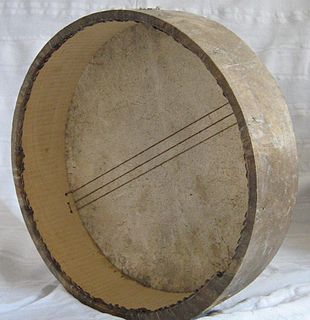 W
WThe bendir is a wooden-framed frame drum of North Africa and Southwest Asia.
 W
WThe buzuq is a long-necked fretted lute related to the Greek bouzouki and Turkish saz. It is an essential instrument in the Rahbani repertoire, but it is not classified among the classical instruments of Arab or Turkish music. However, this instrument may be looked upon as a larger and deeper-toned relative of the saz, to which it could be compared in the same way as the viola to the violin in Western music. Before the Rahbanis popularized the use of this instrument, the buzuq had been associated with the music of Lebanon and Syria.
 W
WThe davul, tapan, atabal or tabl is a large double-headed drum that is played with mallets. It has many names depending on the country and region. These drums are commonly used in the music of Middle East. These drums have both a deep bass sound and a thin treble sound due to their construction and playing style, where different heads and sticks are used to produce different sounds on the same drum.
 W
WThe goblet drum (also chalice drum, tarabuka, tarabaki, darbuka, derbake, debuka, doumbek, dumbec, dumbeg, dumbelek, tabla, tablah, tableh, toumperleki, tumbak, or zerbaghali, is a single head membranophone with a goblet shaped body used mostly in Egypt and is considered the National symbol of Egyptian Shaabi Music, also in parts of the West Asia, North Africa, South Asia, and Eastern Europe. The African djembe-wassolou is also a goblet membranophone. This article focuses on the Eastern and North-African goblet drum.
 W
WThe hammered dulcimer is a percussion-stringed instrument which consists of strings typically stretched over a trapezoidal resonant sound board. The hammered dulcimer is set before the musician, who in more traditional styles may sit cross-legged on the floor, or in a more modern style may stand or sit at a wooden support with legs. The player holds a small spoon-shaped mallet hammer in each hand to strike the strings. The Graeco-Roman dulcimer derives from the Latin dulcis (sweet) and the Greek melos (song). The dulcimer, in which the strings are beaten with small hammers, originated from the psaltery, in which the strings are plucked.
 W
WQraqeb or garagab are a large iron castanet-like musical instrument primarily used as the rhythmic aspect of Gnawa music. Gnawa today is part of the North African culture and is inherent in the Maghrebi soundscape.
 W
WThe mirwās or marwas, plural marāwīs is a small double-sided hand drum originally from the Middle East. It is a popular instrument in the Arab States of the Persian Gulf, used in sawt and fijiri music. It is also common in Kuwait and Yemen.
 W
WIn Arabic music, a mizmār is any single or double reed wind instrument. In Egypt, the term mizmar usually refers to the conical shawm that is called zurna in Turkey and Armenia.
 W
WThe mizwad is a type of bagpipes played in Tunisia, Chakwa in East of Algeria (in French). The instrument consists of a skin bag made from ewe's leather, with a joined double-chanter, terminating in two cow horns, similar to a hornpipe (instrument).This instrument is played with a single-reed.
 W
WThe naqqāra, nagara or nagada is a Middle Eastern drum with a rounded back and a hide head, usually played in pairs. It is thus a membranophone of the kettle drum variety.
 W
WThe ney, is an end-blown flute that figures prominently in Middle Eastern music. In some of these musical traditions, it is the only wind instrument used. The ney has been played continually for 4,500–5,000 years, making it one of the oldest musical instruments still in use.
 W
WThe oud is a short-neck lute-type, pear-shaped stringed instrument, usually with 11 strings grouped in 6 courses, but some models have 5 or 7 courses, with 10 or 13 strings respectively.
 W
WA qanbūs is a short-necked lute that originated in Yemen and spread throughout the Arabian peninsula. Sachs considered that it derived its name from the Turkic komuz, but it is more comparable to the oud. The instrument was related to or a descendant of the barbat, a (possibly) skin-topped lute from Central Asia. The qanbūs has 6 or 7 nylon strings that are plucked with a plectrum to generate sound. Unlike many other lute-family instruments, the gambus has no frets. Its popularity declined in Yemen during the early 20th century reign of Imam Yahya; by the beginning of the 21st century, the oud had replaced the qanbūs as the instrument of choice for Middle-Eastern lutenists.
 W
WThe qanun, kanun, ganoun or kanoon is a string instrument played either solo, or more often as part of an ensemble, in much of the Middle East, North Africa, West Africa, Central Asia, and southeastern regions of Europe. The name derives from the Arabic word qanun, meaning "rule, law, norm, principle", which is borrowed from the ancient Greek word and musical instrument κανών (rule), which in Latin was called canon. Traditional and Classical musics executed on the qanun are based on Maqamat or Makamlar. Qanun trace its origins to a stringed Assyrian instrument from the Old Assyrian Empire, specifically from the nineteenth century BC in Mesopotamia. This instrument came inscribed on a box of elephant ivory found in the old Assyrian capital Nimrud, which is located about 35 km from the city of Mosul in Iraq. The instrument is a type of large zither with a thin trapezoidal soundboard that is famous for its unique melodramatic sound.
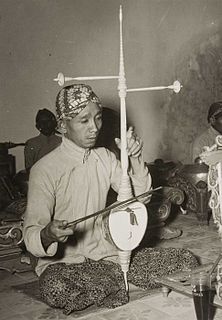 W
WThe rebab is the name of several related bowed string instruments that independently spread via Islamic trading routes over much of North Africa, Southeast Asia, the Middle East, and parts of Europe.
 W
WThe rhaita or ghaita is a double reed instrument from North Africa. It is nearly identical in construction to the Arabic mizmar and the Turkish zurna. The distinctive name owes to a medieval Gothic-Iberian influence. In southern Iberia, various sorts of wind instruments, including the related shawm, are known as gaitas, but in northern Iberia gaita refers only to bagpipes.
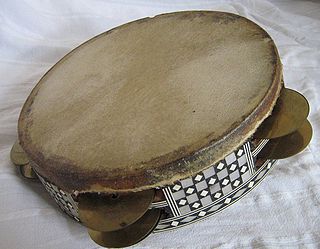 W
WThe riq is a type of tambourine used as a traditional instrument in Arabic music. It is an important instrument in both folk and classical music throughout the Arabic-speaking world. It traditionally has a wooden frame, jingles, and a thin, translucent head made of fish or goat skin.
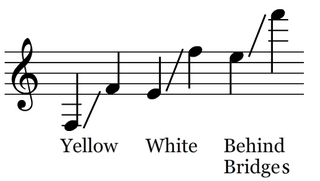 W
WThe santur (Persian: سنتور, is a hammered dulcimer of Iranian or Mesopotamian origins.
 W
WA sistrum is a musical instrument of the percussion family, chiefly associated with ancient Egypt. It consists of a handle and a U-shaped metal frame, made of brass or bronze and between 30 and 76 cm in width. When shaken, the small rings or loops of thin metal on its movable crossbars produce a sound that can be from a soft clank to a loud jangling. Its name in the ancient Egyptian language was sekhem (sḫm) and sesheshet (sššt).
 W
WThe davul, tapan, atabal or tabl is a large double-headed drum that is played with mallets. It has many names depending on the country and region. These drums are commonly used in the music of Middle East. These drums have both a deep bass sound and a thin treble sound due to their construction and playing style, where different heads and sticks are used to produce different sounds on the same drum.
 W
WThe tar is an ancient, single-headed frame drum. It is commonly played in the Middle East and North Africa. The tar's drumhead is struck with one hand.
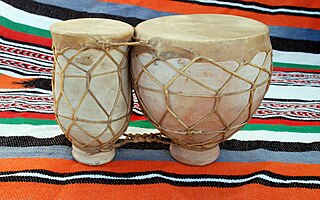 W
WThe tbilat is a percussion instrument from Morocco which resembles bongos and tabla. It consists of a pair of decorated pottery drums, each with different size. The skinheads are stretched by plaited gut cords. This membranophone is placed on the ground between the legs, and played with both hands.
 W
WXalam is a traditional stringed musical instrument from West Africa with 1-5 strings.
 W
WZills, also zils or finger cymbals, are small metallic cymbals used in belly dancing and similar performances. They are called sājāt (صاجات) in Arabic. They are similar to Tibetan tingsha bells. In western music, several pairs of zills can be set in a frame to make a tambourine.
 W
WThe zurna is a double reed wind instrument played in central Eurasia, Western Asia and parts of North Africa. It is usually accompanied by a davul in Anatolian and Assyrian folk music.